Abstract
Hereditary spastic paraplegia (HSP) is a degenerative disorder of the motor system, defined by progressive weakness and spasticity of the lower limbs. HSP may be inherited as an autosomal dominant (AD), autosomal recessive, or an X-linked trait. AD HSP is genetically heterogeneous, and three loci have been identified so far: SPG3 maps to chromosome 14q, SPG4 to 2p, and SPG4a to 15q. We have undertaken linkage analysis with 21 uncomplicated AD families to the three AD HSP loci. We report significant linkage for three of our families to the SPG4 locus and exclude several families by multipoint linkage. We used linkage information from several different research teams to evaluate the statistical probability of linkage to the SPG4 locus for uncomplicated AD HSP families and established the critical LOD-score value necessary for confirmation of linkage to the SPG4 locus from Bayesian statistics. In addition, we calculated the empirical P-values for the LOD scores obtained with all families with computer simulation methods. Power to detect significant linkage, as well as type I error probabilities, were evaluated. This combined analytical approach permitted conclusive linkage analyses on small to medium-size families, under the restrictions of genetic heterogeneity.
Full text
PDF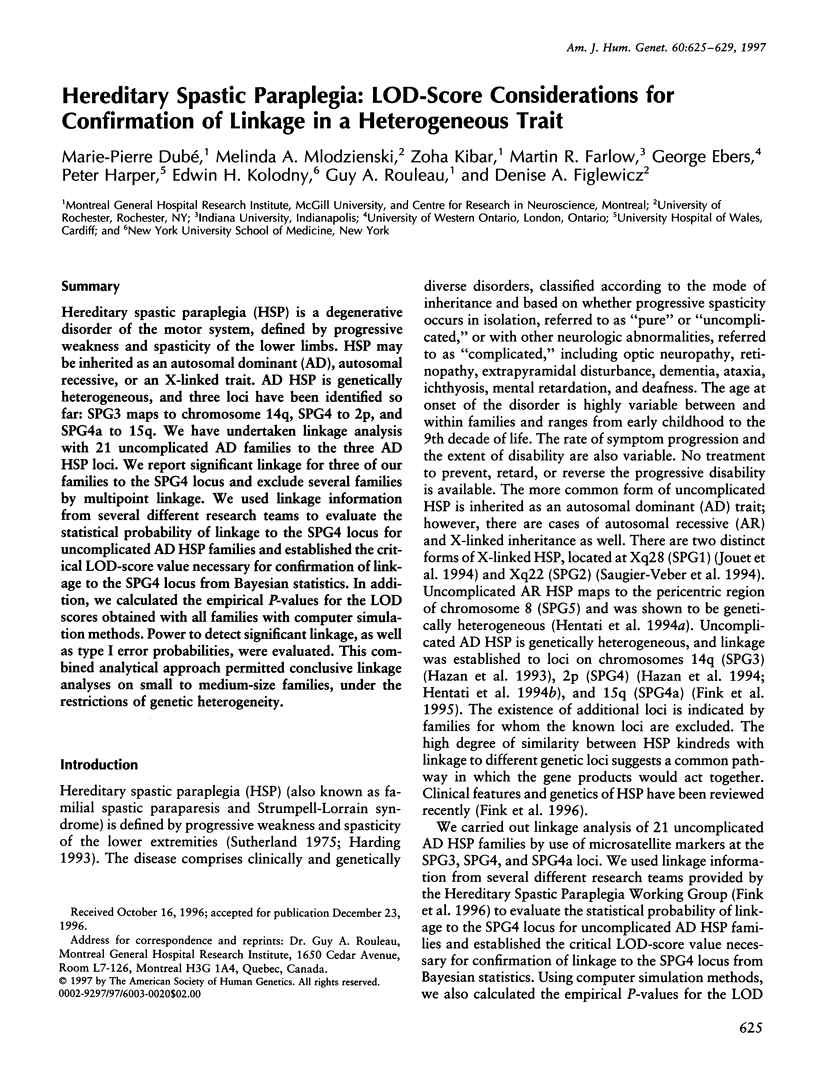
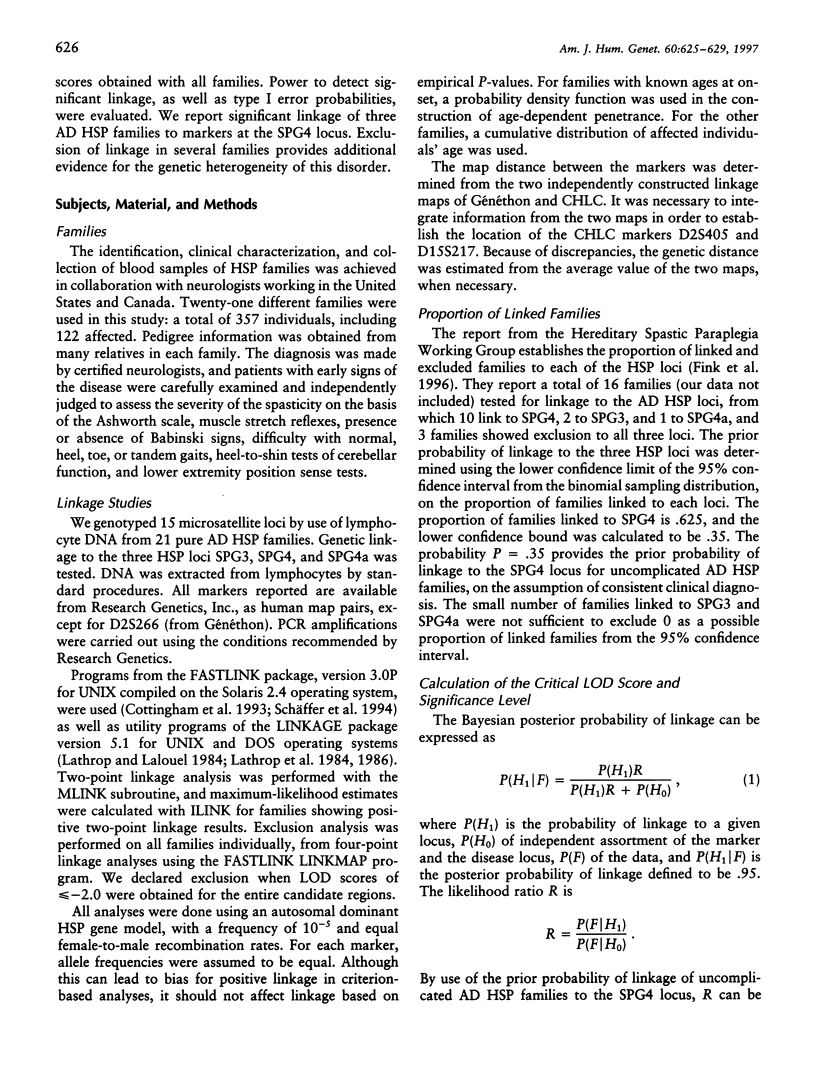
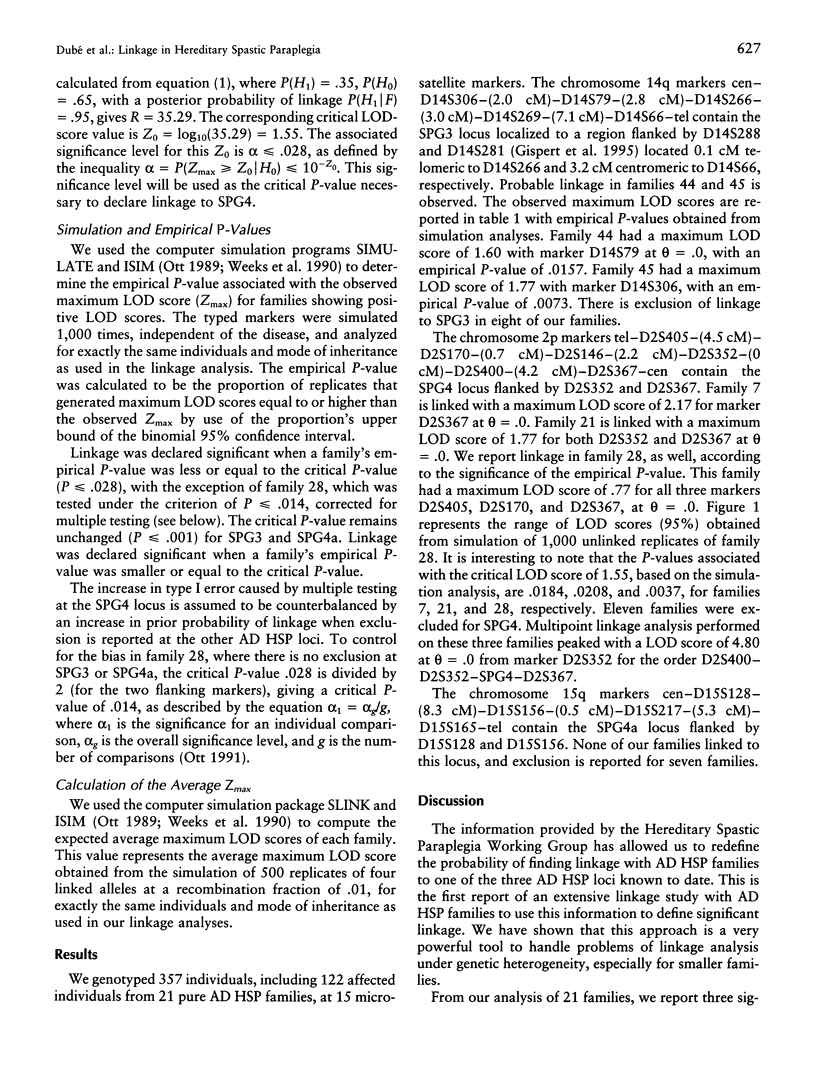
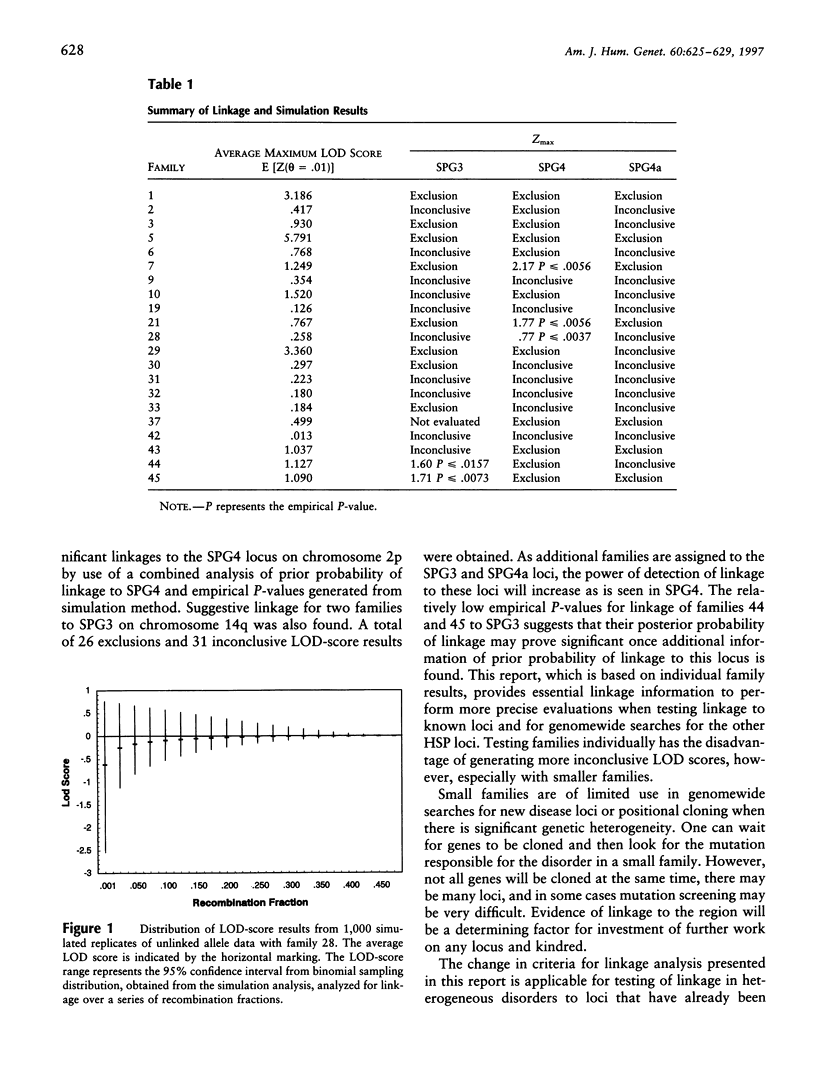
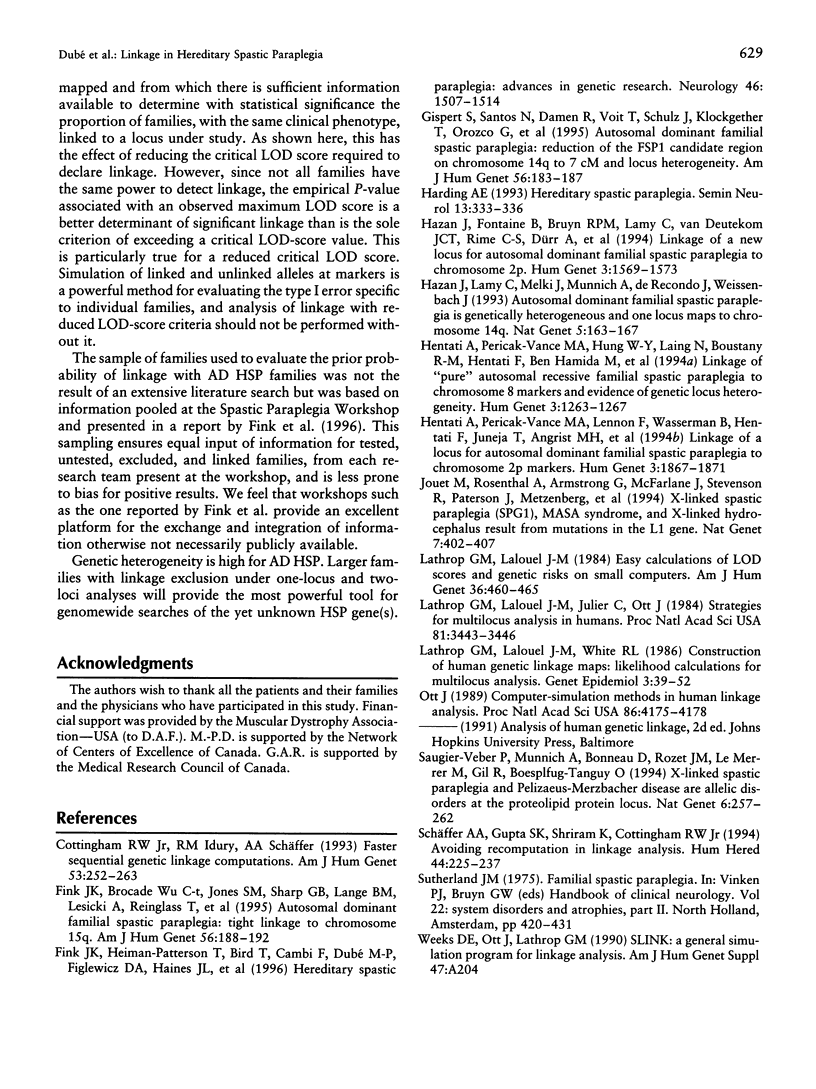
Selected References
These references are in PubMed. This may not be the complete list of references from this article.
- Cottingham R. W., Jr, Idury R. M., Schäffer A. A. Faster sequential genetic linkage computations. Am J Hum Genet. 1993 Jul;53(1):252–263. [PMC free article] [PubMed] [Google Scholar]
- Fink J. K., Heiman-Patterson T., Bird T., Cambi F., Dubé M. P., Figlewicz D. A., Fink J. K., Haines J. L., Heiman-Patterson T., Hentati A. Hereditary spastic paraplegia: advances in genetic research. Hereditary Spastic Paraplegia Working group. Neurology. 1996 Jun;46(6):1507–1514. doi: 10.1212/wnl.46.6.1507. [DOI] [PubMed] [Google Scholar]
- Fink J. K., Wu C. T., Jones S. M., Sharp G. B., Lange B. M., Lesicki A., Reinglass T., Varvil T., Otterud B., Leppert M. Autosomal dominant familial spastic paraplegia: tight linkage to chromosome 15q. Am J Hum Genet. 1995 Jan;56(1):188–192. [PMC free article] [PubMed] [Google Scholar]
- Gispert S., Santos N., Damen R., Voit T., Schulz J., Klockgether T., Orozco G., Kreuz F., Weissenbach J., Auburger G. Autosomal dominant familial spastic paraplegia: reduction of the FSP1 candidate region on chromosome 14q to 7 cM and locus heterogeneity. Am J Hum Genet. 1995 Jan;56(1):183–187. [PMC free article] [PubMed] [Google Scholar]
- Harding A. E. Hereditary spastic paraplegias. Semin Neurol. 1993 Dec;13(4):333–336. doi: 10.1055/s-2008-1041143. [DOI] [PubMed] [Google Scholar]
- Hazan J., Fontaine B., Bruyn R. P., Lamy C., van Deutekom J. C., Rime C. S., Dürr A., Melki J., Lyon-Caen O., Agid Y. Linkage of a new locus for autosomal dominant familial spastic paraplegia to chromosome 2p. Hum Mol Genet. 1994 Sep;3(9):1569–1573. doi: 10.1093/hmg/3.9.1569. [DOI] [PubMed] [Google Scholar]
- Hazan J., Lamy C., Melki J., Munnich A., de Recondo J., Weissenbach J. Autosomal dominant familial spastic paraplegia is genetically heterogeneous and one locus maps to chromosome 14q. Nat Genet. 1993 Oct;5(2):163–167. doi: 10.1038/ng1093-163. [DOI] [PubMed] [Google Scholar]
- Hentati A., Pericak-Vance M. A., Hung W. Y., Belal S., Laing N., Boustany R. M., Hentati F., Ben Hamida M., Siddique T. Linkage of 'pure' autosomal recessive familial spastic paraplegia to chromosome 8 markers and evidence of genetic locus heterogeneity. Hum Mol Genet. 1994 Aug;3(8):1263–1267. doi: 10.1093/hmg/3.8.1263. [DOI] [PubMed] [Google Scholar]
- Hentati A., Pericak-Vance M. A., Lennon F., Wasserman B., Hentati F., Juneja T., Angrist M. H., Hung W. Y., Boustany R. M., Bohlega S. Linkage of a locus for autosomal dominant familial spastic paraplegia to chromosome 2p markers. Hum Mol Genet. 1994 Oct;3(10):1867–1871. doi: 10.1093/hmg/3.10.1867. [DOI] [PubMed] [Google Scholar]
- Jouet M., Rosenthal A., Armstrong G., MacFarlane J., Stevenson R., Paterson J., Metzenberg A., Ionasescu V., Temple K., Kenwrick S. X-linked spastic paraplegia (SPG1), MASA syndrome and X-linked hydrocephalus result from mutations in the L1 gene. Nat Genet. 1994 Jul;7(3):402–407. doi: 10.1038/ng0794-402. [DOI] [PubMed] [Google Scholar]
- Lathrop G. M., Lalouel J. M. Easy calculations of lod scores and genetic risks on small computers. Am J Hum Genet. 1984 Mar;36(2):460–465. [PMC free article] [PubMed] [Google Scholar]
- Lathrop G. M., Lalouel J. M., Julier C., Ott J. Strategies for multilocus linkage analysis in humans. Proc Natl Acad Sci U S A. 1984 Jun;81(11):3443–3446. doi: 10.1073/pnas.81.11.3443. [DOI] [PMC free article] [PubMed] [Google Scholar]
- Lathrop G. M., Lalouel J. M., White R. L. Construction of human linkage maps: likelihood calculations for multilocus linkage analysis. Genet Epidemiol. 1986;3(1):39–52. doi: 10.1002/gepi.1370030105. [DOI] [PubMed] [Google Scholar]
- Ott J. Computer-simulation methods in human linkage analysis. Proc Natl Acad Sci U S A. 1989 Jun;86(11):4175–4178. doi: 10.1073/pnas.86.11.4175. [DOI] [PMC free article] [PubMed] [Google Scholar]
- Saugier-Veber P., Munnich A., Bonneau D., Rozet J. M., Le Merrer M., Gil R., Boespflug-Tanguy O. X-linked spastic paraplegia and Pelizaeus-Merzbacher disease are allelic disorders at the proteolipid protein locus. Nat Genet. 1994 Mar;6(3):257–262. doi: 10.1038/ng0394-257. [DOI] [PubMed] [Google Scholar]
- Schäffer A. A., Gupta S. K., Shriram K., Cottingham R. W., Jr Avoiding recomputation in linkage analysis. Hum Hered. 1994 Jul-Aug;44(4):225–237. doi: 10.1159/000154222. [DOI] [PubMed] [Google Scholar]


